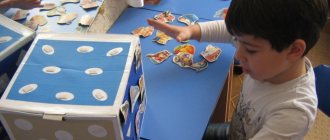Types of motives typical for preschool age
1. Motives related to children’s interest in the world of adults , with their desire to act like adults. The desire to be like an adult guides the child in role-playing play. Often, such a desire can be used as a means to get the child to fulfill one or another requirement in everyday behavior. “You’re big, and big people dress themselves,” they say to the child, encouraging him to be independent. “Big people don’t cry” is a strong argument that forces a child to hold back his tears.
2. Gaming motives associated with interest in the game process itself. Etymotivs appear in the course of mastering gaming activities and are intertwined with the desire to act like an adult. Going beyond play activities, they color the entire behavior of the child and create the unique specifics of preschool childhood. A child can turn any activity into a game. Very often, when it seems to adults that the child is busy with serious work or diligently studying something, he is actually playing, creating an imaginary situation for himself.
3. Motives for establishing and maintaining positive relationships with adults and other children.
A child needs a good attitude from others. The desire to earn affection, approval, and praise from adults is one of the main levers of his behavior.
Many children's actions are explained precisely by this desire. The desire for positive relationships with adults forces the child to take into account their opinions and assessments and follow the rules of behavior they establish.
4. Motives of pride, self-affirmation
Their starting point is the separation of oneself from other people, which occurs at the turn of early childhood and preschool age, and the attitude towards an adult as a model of behavior. Adults not only go to work, engage in types of work that are honorable in the eyes of a child, and enter into various relationships with each other. They also raise him, the child, make demands and achieve their fulfillment. And the child begins to claim that others respect and listen to him, pay attention to him, and fulfill his desires.
One of the manifestations of the desire for self-affirmation is children’s claims to play the main roles in games. It is significant that children, as a rule, really do not like to take on the roles of children. The role of an adult with respect and authority is always much more attractive. In children three to five years old, self-affirmation is also revealed in the fact that they attribute to themselves all the positive qualities known to them, without caring about their correspondence to reality, exaggerate their courage, strength, etc. When asked if he is strong, the child answers that , of course, he is strong, because he can lift “even an elephant.”
5. Cognitive and competitive motives
Already at three or four years old, a child can literally bombard those around him with questions: “What is this?”; "But as?"; "For what?" etc. Later, the question “Why?” becomes dominant. Often children not only ask, but try to find the answer themselves, use their little experience to explain something incomprehensible, and sometimes even conduct an “experiment.” It is well known how children love to “gut” toys, trying to find out “what is inside them.” These facts are often considered an indicator of the inherent curiosity of preschool children.
However, in fact, children's questions do not always express their cognitive interest, the desire to obtain any new information about the world around them. Most of the questions asked by primary and secondary preschoolers are aimed at attracting the attention of an adult, inviting him to communicate, and sharing with him the experience that has arisen. Children often do not wait and do not listen to answers to their questions, interrupt the adult and jump to new questions.
Parental mistakes: what not to do?
Often people moving towards their goal give up because no one told them simple words: “You will succeed. I believe in you!". Sometimes this basic support is enough for motivation.
For some children, motivation disappears before it appears, while for others it loses its strength over time. Why does this happen? Let's talk about options for parental mistakes.
- Violence in education:
- physical violence;
- psychological violence (threats, suppression of personality, etc.).
- Lack of clear organization of the child’s life: there is no daily routine, the child is left to his own devices.
- There is no unity of demands on the part of the parents (mom prohibits, dad allows; with grandma it’s possible, parents won’t find out, etc.).
- Excessive demands on the child.
- Overprotection.
- Lack of attention to the child's preferences.
To summarize all of the above, I would like to wish you, dear parents, that you do not miss the opportunity to live your life, and not the life of a child: have your own interests, hobbies, hobbies, set goals for yourself and achieve them, and be motivated. This will be the most striking example of proper motivation for your children!
Try to act individually, look for ways of motivation that are suitable specifically for your situation. At the same time, do not forget to respect the interests, desires, and aspirations of your children. And be sure to tirelessly show them your love!
Use of game motifs
Currently, science and practice have developed many gaming methods and teaching techniques, but which, unfortunately, are not always effective.
Firstly, because the game situation created by the teacher does not captivate children, does not give them joy, like a game, and does not develop them.
Secondly, because gaming methods and techniques do not contribute to the effective mastery of the skills for which they are, in fact, used.
Let's look at this with specific examples.
For example, educators often resort to a gaming technique that involves simulating a particular game character coming to visit children.
The teacher pretends to knock on the door, and then, opening it, announces to the children that someone has “come” to them.
The age range for using this game technique is from 2 to 7 years. And if children 2-3 years old are with genuine, sincere interest in the “arrival” of a toy or a “bi-ba-bo” toy or doll, then for older children this technique is not only ineffective, but can even cause poorly hidden ridicule.
Younger and older preschoolers also treat the “requests” of the game character differently: the kids are willing to do so, while the older ones are indifferent. Children 2-3 years old, who have already mastered play action (make-believe action), are really ready to “help” the toy and “fulfill” its request, having made some effort for this. But for this, the toy must literally become closer to the child. He must take her in his hands, act with her, “talk”, and then, perhaps, want to do something for her.
But in most cases, the teacher manipulates the guest toy. And she is at a considerable and inaccessible distance from the children. Therefore, at best, each child only manages to stroke her.
As a result, apart from the effect of novelty, this gaming technique does not have any emotional or playful impact on young children.
Unfortunately, when working with children aged 5-7 years, the “make-believe” world of children’s play also does not always contribute to the effective solution of educational problems for which play methods are used.
In this regard, the selection and use of gaming methods and techniques should be based on the principle: gaming methods and techniques should correspond to the methods of constructing role-playing games for children of a given age. Let's look at this with specific examples.
Thus, in early preschool age, role-playing game is characterized by the implementation of play actions (drive a car, unload or load it, feed a doll, put it to bed, etc.)
Therefore, in accordance with this principle, when teaching younger preschoolers, play methods and techniques should be used taking into account the development of the child’s play actions, as well as their direct inclusion in the learning process: draw a road and then “drive” along it in a small toy car ; “loaded” the car by drawing in the back what it was carrying; made cookies from clay or plasticine - fed (pretend) a toy that is nearby, etc.
In middle preschool age, children's role-playing play is characterized by role-taking and role-playing behavior (in the role of a bunny, the child builds a house for himself, prepares dinner, etc.)
Following the principle of matching the level of development of play with play methods when teaching children of middle preschool age, play methods and techniques should include role acceptance and role-playing behavior. So, for example, in the role of a rabbit, children can “harvest” vegetables - sculpt carrots, beets, etc.
In older preschool age, role-playing games are in the phase of plot development: children can invent, combine and develop the plot of the game based on personal experience, works of art, various events, fantasy, etc.
Consequently, when teaching children of senior preschool age, gaming methods and techniques should include game motivation based on plot development. The content of play motivation can combine various events and the actions of characters from works of art into a single plot that is interesting for a modern child and encourages him to complete educational tasks.
How to learn a poem
To begin with, we present to your attention ways to memorize a poem with preschoolers:
Method 1. Teach with expression, loudly, emotionally
Immerse your child in the beauty of poetic form, and he is unlikely to refuse you.
Method 2. Draw poetry
Make your own illustration of the poem, indicate the authors and age. Keep a separate folder for such drawings and sign all works. Then, looking through the pictures, try to reproduce the previously memorized poems from memory.
Method
3. Tape recorder
Tell the child that the book needs to be given to neighbor Masha, and now while we have it, let’s turn on our tape recorder in our heads and record a poem. Read the phrases several times - record them on a tape recorder. And so verse after verse.
The use of motivation techniques in the educational process
A) “Help the toy”, the child achieves the learning goal by solving the problems of the toys. The creation of this motivation is based on this scheme:
1. The teacher says that the toy needs help, and only children can help it.
2. The teacher asks the children if they agree to help the toy.
3. The teacher offers to teach children to do what the toy requires, then the explanation and demonstration will interest the children.
4. During work, each child should have his own character - a mentee (or a toy - a mentee evaluates the child’s work and always praises the child.
6. After finishing work, it is advisable for the children to play with their charges.
7. With this motivation, the child acts as an assistant and protector, and it is appropriate to use it for teaching various practical skills.
B). Creating a problem situation
The teacher models a situation in which children are faced with a difficulty in their activity: in order to achieve their “children’s” goal, the child needs to perform a certain action, let’s call it a “trial” action. But the implementation of this “trial” action is based on that new knowledge (concept or method of action) that the child has yet to “discover” and which he does not yet have at the moment.
This raises a difficulty. The teacher, using a system of questions (“Could you?” - “Why couldn’t you?”) helps children gain experience in recording the difficulty and identifying its cause. Since the difficulty is personally significant for each child (it interferes with the achievement of his “childish” goal), children have an internal need to overcome it, that is, now a new goal associated with cognition (an educational task correlated with an “adult” goal ).
C) Using the subjective experience of a preschooler
To do this, the teacher, as a rule, includes children in a conversation that is necessarily related to their life experience and is personally significant for them. The sources of the formation of the situation can be real events occurring in the surrounding life (vivid natural phenomena, holidays, incidents in the lives of children and their families, events occurring in the life of a group), imaginary events, events described in fiction, etc. Key phrases of completion stage are the questions: “Do you want?”, “Can you?”.
D) Helping an adult - “Help me.” Here, the motive for children is communication with an adult, the opportunity to gain approval, as well as interest in joint activities that can be done together.
Creation of motivation is based on the following scheme:
1. The teacher tells the children that he is going to make something and asks the children to help him. He wonders how they can help him.
2. Each child is given a feasible task.
3. At the end, the teacher emphasizes that the result was achieved through joint efforts, that everyone came to it together.
D) “Teach me” - is based on the child’s desire to feel knowledgeable and capable.
The creation of this motivation is carried out according to this scheme:
1. The teacher informs the children that he is going to engage in some activity and asks the children to teach him this.
2. The teacher asks if they agree to help him.
3. Each child is given the opportunity to teach the teacher something to do.
4. At the end of the game, each child is given an assessment of his actions and must be praised.
E) “Creating objects with your own hands for yourself is based on the child’s inner interest. This motivation encourages children to create objects and crafts for their own use or for their loved ones. Children are sincerely proud of their crafts and willingly use them.
This motivation is created according to the following scheme:
1. The teacher shows the children some kind of craft, reveals its advantages and asks if they would like to have the same one for themselves or for their relatives.
2. Next he shows everyone how to make this item.
3. The completed craft is given to the child. Pride in one’s own hands is the most important basis for a creative attitude to work. If the child is already busy with some activity of interest, and therefore already has the necessary motivation, you can introduce him to new ways to solve problems.
Process of involvement in activities:
1. Introduce something so that most children are interested.
2. Remove something, leaving an empty space (there are no dolls or cars left in the group, etc.)
3. Someone or a toy comes to visit.
4. The effect of surprise (noise, crackling, knocking...).
5. Do something unusual in the presence of children with a request to move away and not disturb (look closely out the window, etc.).
6. Intrigue (wait, after charging I’ll tell you; don’t look, I’ll show you after breakfast; don’t touch, it’s very fragile, it’ll ruin it; for example, it snowed, before the children arrive, hang a sheet on the window “Guys, don’t look yet, I have such a beautiful painting, we’ll talk about it later”).
7. Agree with the parents to dress the child in something of a certain color; the cook invites you over and asks you to do something; the music director promises interesting entertainment, but we need help with this.
8. A specially organized situation (replace all soap with pebbles, chalk with a lump of sugar).
9. The child’s birthday (teacher: “Guys, put the candy wrappers in the box, I need them for a surprise.” The children are interested: “Which one?”).
10. The teacher needs the children’s help in something specific, he makes a request to the children. If a boy or a shy child wants to say something, ask them first, and only then let the girls speak.
Conclusion.
When motivating children, the following principles should be observed:
-you cannot impose your vision on solving a problem on a child (maybe the child will have his own way of solving the problem)
- be sure to ask the child for permission to do a common activity with him.
- be sure to praise the child’s actions for the results obtained.
-acting together with your child, you introduce him to your plans
- ways to achieve them.
By following these rules, you give children new knowledge, teach them certain skills, and develop the necessary skills. Each activity should contain something that will cause surprise, amazement, delight, that children will remember for a long time. We must remember the saying “Knowledge begins with wonder.” It is important to take into account the age of the children; techniques that are suitable for younger - middle age, but not suitable for the older and preparatory groups.
Love for work
Introducing a child to work is not an easy task, but there are also little tricks to cope with this task.
Tell your children about your work (why you fill the washing machine and why you need a vacuum cleaner in the house), teach your children through play. To begin with, let the child next to you pretend to wash the children's dishes, wipe the floors (as best he can, as he wants) - repeating after his mother. For example, our three-year-old son already skillfully handles a vacuum cleaner (we trust him with household appliances that are easy to operate, having first taught him how to use them). Also, our son can choose and start the desired mode of the washing machine himself, loading it together with his mother.
You can also get involved in work using the following techniques:
- A positive example (seeing how mom and dad are constantly learning something new themselves, getting real pleasure from it, the child will certainly want to be like you)
- Stories of secrets (about cooking, the intricacies of everyday life or men's work)
- A reward for each errand (buying a small toy, going to an amusement park for children)
- Praise (do not spare kind words for children, and do not criticize in any way)
Porridge is our joy
If your baby refuses to eat porridge, then it is just porridge. And who would eat such an ordinary one?!
For the baby it is of great importance:
- The appearance of the porridge, that is, its design. Be inspired by the experience of professional restaurateurs and fantasize yourself. Be sure to alternate porridges: on Monday – buckwheat, Tuesday – corn, Wednesday – oatmeal and so on.
- Come up with your own fascinating tales with each porridge, and only after the next spoon tell the continuation.
- Follow the principle: more fruit - less porridge, and your baby will definitely appreciate it.
Children very sensitively feel the mood of their parents, especially their mother. Be wise and patient in everything and always. Don't take it out on your children. And you will see that after some time your baby will come to you on his own and say: “Mom, I’m sorry, please, I won’t do this again!”
We really hope that our simple tips will be useful to you.
Reviews and comments
Please share with us methods of motivating preschoolers, use the line below for this.
Good luck to you!
PS
Modern life is no longer surprising. Unfortunately, it has become not uncommon and has long been no longer an anomaly for parents to dislike their children. This topic is deep, painful and very relevant, so we will definitely cover it in subsequent issues.
We also recommend reading:
- Storytelling
- A selection of courses for children and parents
- Getting ready for the new school year
- How to motivate a child to read?
- How to teach a child to read: rules, tips and tricks
- Piaget's theory of cognitive development
- Factors in a child’s intellectual development
- Development of communication skills in children
- Cognitive development. Part 2
- Psychosocial development theory
- How to raise a child correctly?
Key words:1Children





